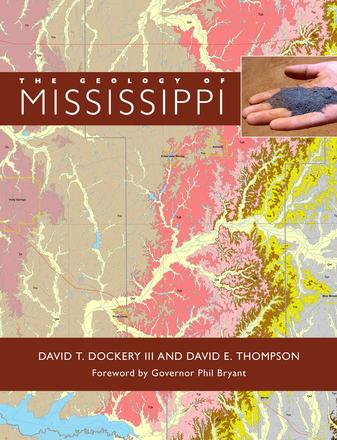
The Geology of Mississippi
The first comprehensive treatment of the state’s fascinating geological history
Description
The Geology of Mississippi is an encyclopedic work by authors with extensive experience in Mississippi's surface geology mapping program. It brings together published work, unpublished work from agency files, and the authors' experience, both in personal field work and in collaboration with experts from around the world.
With over a thousand images, the voluminous text relates ways in which Mississippi's geology has contributed to the understanding of global events, such as the extinction of the dinosaurs and the first occurrence of tiny primates. Fossil illustrations include Devonian trilobites, Mississippian scale trees, Pennsylvanian brachiopods, Cretaceous dinosaur bones, Paleocene lignite and petrified wood, Eocene seashells and the excavation of fossil whales, Oligocene marine fossils and rare land mammal finds, Miocene plants and animals, Paleozoic marine fossils, and the bones of giant ice-age mammals. The text is arranged by geologic age.
Economic minerals cited in the book include oil and gas (both methane and carbon dioxide), lignite, dimension stone, crushed stone, sand and gravel, various clay deposits, limestone, and potential economic deposits of bauxite, heavy minerals, and iron ore. Groundwater is Mississippi's most valuable natural resource and supplies over ninety percent of the state's public and industrial water supply and most of the state's irrigation supply for agriculture and catfish ponds. Mississippi's surface geology causes the state's fertile and not-so-fertile soil types responsible for foundation and infrastructure substrates that range from stable to failure-prone due to expansive clays. Finally, The Geology of Mississippi, coupled with site-specific surface geologic maps, provides information for the wise use of land and the environmental protection of the state's resources.
Reviews
"If you want to know why Mississippi is built the way it is, then look no further. For more than 600 pages, they tell you all that you would ever want to know about our geologic history. It is a fascinating read. And for those looking ahead to what I predict will be one of the next major political battles—how we use and conserve our underground water—The Geology of Mississippi explains in great detail where the aquifers are located, how they got there, and what may become of them. You can almost see where the political lines will be drawn based on geology explained by Dockery and Thompson. The Geology of Mississippi is a great one-stop shop for anything you may want to know about our state's environmental history."
- Jere Nash, coauthor of Mississippi Politics: The Struggle for Power, 1976-2008, Second Edition; Mississippi Fried Politics: Tall Tales from the Back Room; and America's Great Storm: Leading through Hurricane Katrina
"This magnificent book will be a fundamental resource for every geologist and paleontologist working or interested in the Gulf Coast. Its beautiful and abundant illustrations, combined with exhaustive and authoritative yet very readable text, make it a landmark in our understanding of the stunningly diverse and important geology of this section of the country. The authors' broad and deep expertise is evident on every page. They have produced a model for how to write seriously about regional geology for a wide audience in the early twenty-first century. It is a remarkable achievement."
- Warren D. Allmon, director, Paleontological Research Institution, and Hunter R. Rawlings III Professor of Paleontology, Department of Earth and Atmospheric Sciences, Cornell University